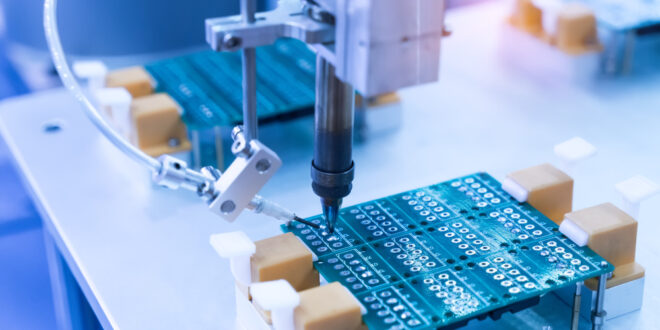When dealing with small PCB orders, some small companies may solder the components by hand. This requires time and dedication, but this is usually not a problem when it comes to manufacturing small quantities. However, when it is necessary to make a large number of PCBs, the whole process is approached in a completely different way. PCB assembly machines and various equipment are used to install a large number of small components on the PCB in a very short time. Professional prefabricated houses can boast of such products and usually have a number of different PCB assembly machines and tools that allow maximum efficiency in production in a minimum of time.
In order to bring you closer to the whole story, below we talk in more detail about the different PCB assembly machines and tools. You will learn everything you need if you plan to start your production process. Let’s go!
Table of Contents
1. Automated PCB assembly machines for through-hole soldering
What is through-hole soldering?
Before we share with you what automated PCB assembly machines for through-hole soldering are, we need to first say more about this technology. Trough-hole soldering was dominant before the invention of SMT and was very popular until the 1990s. It involves the use of leads that pass through holes for electrical components that are drilled into the PCB to mount these components and then soldered to pads on the opposite side of the PCB.
Although today SMT devices are mostly used, this does not mean that through-hole technology has fallen into oblivion. Quite the opposite – due to a number of specific advantages it offers it is still used for mounting electrical components on PCBs in some cases. Here are some of the PCB assembly machines used for that purpose:
Wave soldering machine
The main machine for any automatic PCB assembly line for mass production is the wave soldering machine. It got this name because, in the process of soldering components to PCBs, it is necessary for PCBs to pass through the wave of molten solder. This machine is large in size, so it is divided into several different sections, each of which plays a significant role in the printed circuit board assembly process.
Those are:
- Flux sprayer
- Conveyor belt
- Preheater
- A pan of molten solder
- Pump
- Solder pot
We could say that the solder pot is a type of PCB assembly machine that is analogous to a wave soldering machine but is adapted for small production. It is also used to make PCBs that are small in size. It consists of a vessel with molten solder.
If you want to learn all the details about the PCB fabrication process you can read more at pcbasic.com.
2. Automated PCB assembly machines for SMT
SMT (Surface Mount Technology)
In the 1980s, the needs for PCBs in various industries began to increase, so their production grew more and more. During this process, manufacturers saw the shortcomings of trough-hole technology. There were a number of problems, and the main obstacle was insufficiently fast production and high costs. However, over time, SMT (Surface Mount Technology) has been developed, as it has been shown that there is no need to use leads so that components can pass through the board, but it is possible to solder them directly to the PCB. Since then, a large number of PCB assembly machines have been developed that work on this principle. Some of them are:
SMT baking oven/curing oven
For the purpose of baking the solder paste and curing the adhesive in electronics, it is necessary to use different ovens. Baking ovens and curing ovens are two basic types of ovens used in the printed circuit board assembly process. However, baking and curing can be used in the same or different ovens, depending on the needs of the manufacturer.
Reflow soldering machine
Reflow soldering machine is the name for a large oven used to solder electrical components to PCBs. This is definitely one of the most commonly used soldering techniques as it allows the formation of strong electrical connections between components and their pads. During this process, the PCBs in the oven go through zones of different temperatures, the solder paste is constantly melted and hardened, which ultimately achieves the desired effect.
This PCB assembly machine has a number of advantages due to which it is widely used. It is suitable for heavy installation, ensures high-quality welding, and is also a very mass-production plant, which is one of the most important requirements nowadays.
SMT pick and place machine
The SMT pick and place machine is certainly one of the most fun to watch, but it is also certainly one of the most important tools nowadays because it saves a lot of time and provides great results. As its name suggests, this machine is responsible for lifting electrical components and precision mounting on the bare board. The components are placed on top of the solder paste and the whole process takes place much faster than would be the case if performed by a human being.
Another advantage of this machine is that it can work day and night and really saves a lot of time in the printed circuit board assembly process compared to the situation in the past. To better understand the power of SMT pick and place machines you need to know that these machines can achieve a picking and placing speed of 30,000 components in only an hour!
Conclusion
Nowadays, PCBs are present in a large number of different devices, in different industries. The needs for their production are really great, which requires highly efficient tools that can deliver the product of the desired quality in the shortest possible time. Until the 1990s, the most commonly used technology for soldering components to PCBs was through-hole, but nowadays surface mount technology is much more useful due to its many advantages. Various PCB assembly machines and tools are available on the market that ensures fast and quality PCB production. Depending on the required quantity of PCBs and the desired effects, some machines and tools will be more suitable than others. We advise you to further educate yourself on this topic before you step into the PCB production world.
 World Magazine 2024
World Magazine 2024





